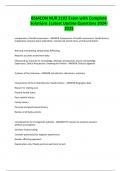BSMCON NUR 2102 Exam with Complete
Solutions |Latest Update Questions 2024-
2025
components of health assessment - ANSWER Components of health assessment- health history
(subjective), physical exam (objective)- includes lab and dx tests, and documentation
Noticing, Interpreting, Responding, Reflecting
Requires accurate assessment data
Influenced by: Experience, Knowledge, Attitude, perspectives; Nurse's Knowledge,
Experience, Ethical Perspective, Knowing the Patient - ANSWER Clinical Judgment
3 phases of the interview - ANSWER introduction, discussion, summary
Components of the Comprehensive Health History - ANSWER Biographic data
Reason for seeking care
Present health status
Past medical history
Family history
Personal and psychosocial history
Review of all body systems
considerations for Transgender patients - ANSWER PE relevant to anatomy present
without assumptions
Sensitive history taking
Consider potential prior negative experiences
Gender affirming approach
Examination only if body parts are pertinent to visit
,Hormone therapy patients --> secondary sex characteristics
Common data collected during the shift assessment - ANSWER Vital Signs: T, P, R, BP and O2
saturation
Neurologic: Oriented to person, place, time and situation.
Communication: Speech clear and appropriate
Cardiac: S1 and S2, Rate, Rhythm, Radial and pedal pulse, Warmth of extremities, capillary refill
Lungs and respiratory system: ease of breathing, skin color, symmetry of thorax, lung sounds
Abdomen and GI system: Appearance of abdomen, bowel sounds, light palpation of
the abdomen
Musculoskeletal system: Compare for symmetry
Skin: Turgor and intactness
EQUIPMENT: catheters, or tubes—location, patency and description of drainage
the study of heredity; examines the function and composition of a single gene - ANSWER
genetics
the study of genes and their function; incorporates all the genes and their interrelationships so
as to understand their combined effect on growth and development - ANSWER genomics
*Demonstrates an understanding of the relationship of genetics/genomics to health,
prevention, screening, diagnostics, prognostics, selection of treatment, and monitoring of
treatment effectiveness
*Demonstrates ability to elicit a minimum of three generation family health history information
*Constructs pedigree from collected family history information using standardized symbols and
terminology
*Collects personal, health and developmental histories that consider genetic,
environmental, and genomic influences and risks
*Conducts comprehensive health and physical assessments that incorporates knowledge
about genetic, environmental, and genomic influences and risk factors
,*Critically analyzes the history and physical assessment findings for genetic, environmental,
and genomic influences and risk factors
*Assesses clients' knowledge, perceptions, and responses to genetic and genomic
information *Develops plan of care t - ANSWER required competencies of the RN
inspection, palpation, percussion, auscultation - ANSWER Four Basic Techniques of
Physical Assessment
What do I see?
All body systems included
Always first
Provide appropriate drape
Seems easy, need practice to master
Possible equipment: penlight, otoscope, ophthalmoscope, speculum - ANSWER inspection
What do I feel?
For: texture, size, shape, consistency, location, identify painful areas
Palmar surface and finger tips
Light- 1cm (always first)
Deep- 4cm
Dorsal surface for temperature
Gentle touch, warm hands, and short nails to prevent discomfort or injury to client
Touch has cultural symbolism and significance.
State purpose, manner, and location of touching.
Wear gloves when palpating mucous membranes or other areas where contact with body fluids
is possible.
PAINFUL AREAS LAST - ANSWER palpation
, What do I hear?
Evaluate: size, borders, consistency, tenderness, fluid
Five tones:
Tympany- loud, high-pitch- abdomen
Resonance- normal lung tissue
Hyperresonance- overinflated lungs such as emphysema
Dullness- over liver and solid organs
Flatness- bones and muscle - ANSWER percussion
What do I hear?
Listening to sounds within the body
Uses stethoscope- blocks out extraneous sounds
Listen for sound and characteristics:
Intensity
Pitch
Duration
Quality
Helpful tip: close your eyes when listening to block out other sensory information
Optimize quality:
Quiet room
Place stethoscope DIRECTLY on skin NOT over top of clothes
Friction of body hair can sound like abnormal sounds- crackles in the lungs - ANSWER
auscultation
Finger nail polish usually has to be removed in order to get an accurate reading
Fingers needs to be warmed
Can also use ear lobe




